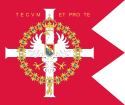
Back تاج مملكة بولندا Arabic Polşa Krallığı Taxt-tacı Azerbaijani Карона Каралеўства Польскага Byelorussian Карона Каралеўства Польскага BE-X-OLD Koruna polského království Czech Kongeriget Polens krone Danish Krone des Königreichs Polen German Στέμμα του Βασιλείου της Πολωνίας Greek Krono de la Regno de Pollando Esperanto Corona del Reino de Polonia Spanish
Crown of the Kingdom of Poland | |||||||||||||
|---|---|---|---|---|---|---|---|---|---|---|---|---|---|
| 1385–1795 | |||||||||||||
| Anthem: "Bogurodzica" "Mother of God" "Gaude Mater Polonia"[1] "Rejoice, oh Mother Poland" | |||||||||||||
 The Crown of the Kingdom of Poland (red) within the Polish–Lithuanian Commonwealth in 1635. | |||||||||||||
| Status | Part of the Polish–Lithuanian Commonwealth (1569–1795) | ||||||||||||
| Capital | Kraków | ||||||||||||
| Official languages | Polish, Latin | ||||||||||||
| Religion | Roman Catholicism (state religion)[2] | ||||||||||||
| Demonym(s) |
| ||||||||||||
| Government | Feudal elective mixed monarchy | ||||||||||||
| Legislature | Sejm | ||||||||||||
| Senate | |||||||||||||
| Chamber of Deputies | |||||||||||||
| Historical era | |||||||||||||
| 14 August 1385 | |||||||||||||
| 1 July 1569 | |||||||||||||
| 3 May 1791 | |||||||||||||
| 7 January 1795 | |||||||||||||
| Currency | |||||||||||||
| |||||||||||||
The Crown of the Kingdom of Poland (Polish: Korona Królestwa Polskiego; Latin: Corona Regni Poloniae) was a political and legal concept formed in the 14th century in the Kingdom of Poland, assuming unity, indivisibility and continuity of the state. Under this idea, the state was no longer seen as the patrimonial property of the monarch or dynasty, but became a common good of the political community of the kingdom.[3] This notion allowed the state to maintain stability even during periods of interregnum and paved the way for a unique political system in Poland, characterized by a noble-based parliament and the free election of the monarch.[4] Additionally, the concept of the Crown extended beyond existing borders, asserting that previously lost territories still rightfully belonged to it.[5] The term Crown of the Kingdom of Poland also referred to all the lands under the rule of the Polish king. This meaning became especially significant after the union with the Grand Duchy of Lithuania, when it began to be commonly used to denote the Polish part of the joint Polish-Lithuanian Commonwealth.[6]
The idea of the Crown in Central Europe first appeared in Bohemia and Hungary, from where the model was taken by kings Ladislaus the Short and Casimir III the Great to strengthen their power. During the reign of Louis the Great in Poland, who spent most of his time in Hungary, as well as during the interregnum following his death and the regency during the minority of his daughter Jadwiga, the idea was adopted by the lords of the kingdom to emphasize their own role as co-responsible for the state.[7]
- ^ "Gaude Mater Polonia Creation and History". Retrieved November 14, 2017.
- ^ Davies, Norman (2005). God's Playground A History of Poland: Volume 1: The Origins to 1795. Oxford University Press. p. 130. ISBN 9780199253395.
- ^ Frost 2015, p. 15.
- ^ Frost 2015, p. 14.
- ^ Frost 2015, p. 12.
- ^ Szczur 2002, p. 417.
- ^ Frost 2015, pp. 11–12.

